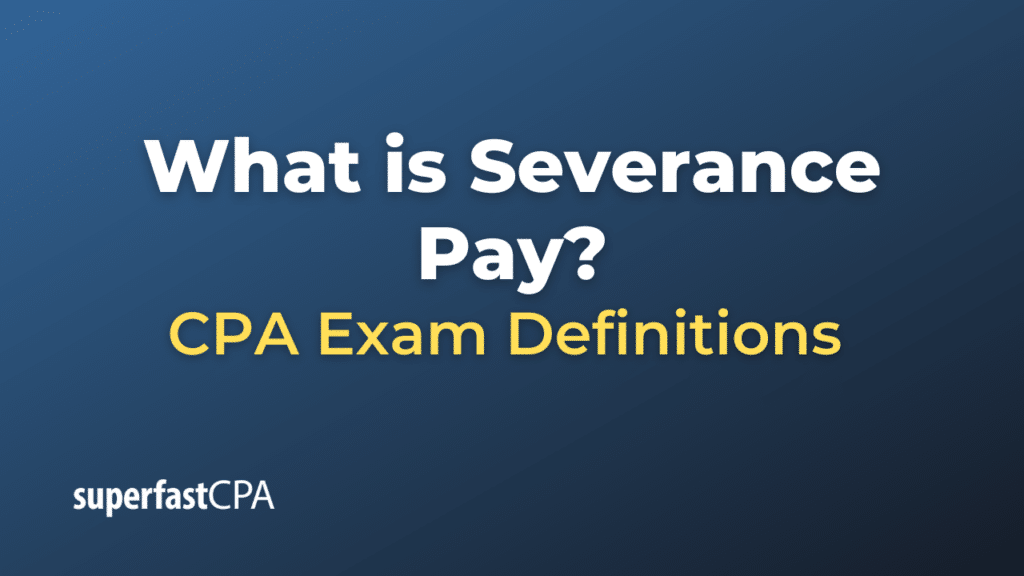Severance Pay
Severance pay is a compensation that an employer provides to an employee who is being terminated or laid off from their position. It is a gesture of goodwill, often used to help employees bridge the financial gap between jobs. The specific reasons for offering severance pay can vary, but it typically comes into play under the following circumstances:
- Redundancy or Layoffs: When a company is undergoing restructuring, downsizing, or closing down a particular unit or the entire operation, affected employees might be offered severance pay.
- Mutual Agreements: Sometimes, both the employer and employee agree that it’s best for the individual to leave the company, even if it wasn’t the employee’s initial intent. In these situations, severance can be part of the negotiated exit package.
- Dismissals: In some cases, if an employee is dismissed for reasons other than misconduct, the employer may provide severance pay as a cushion against sudden unemployment.
The amount and conditions of severance pay can vary widely based on:
- Contractual Agreements: Some employment contracts specify the terms of severance pay.
- Company Policy: Some companies have established policies regarding severance. It might be a set amount or calculated based on years of service, for instance.
- Local Laws and Regulations: Some countries or states have legal requirements for severance pay under specific circumstances.
- Negotiation: In the absence of pre-established terms, the severance amount can sometimes be negotiated between the employer and employee.
Severance packages might also include other benefits, such as:
- Continuation of health insurance for a certain period.
- Payment for unused vacation or sick days.
- Career counseling or job placement services.
- Stock options or vested pension benefits.
While not always mandated by law, severance pay can serve as a protective measure for employees and can also be beneficial for employers, reducing the risk of litigation or reputation damage following layoffs or terminations.
Example of Severance Pay
Let’s use a fictional example to illustrate how severance pay might work in practice.
Example: XYZ Tech Corporation Layoffs
XYZ Tech Corporation is undergoing restructuring due to financial difficulties and has decided to lay off 50 employees from various departments.
Company Policy on Severance: XYZ’s company policy offers severance pay based on years of service. Specifically:
- Less than 1 year of service: 2 weeks of base salary.
- 1-3 years of service: 1 month of base salary.
- 3-5 years of service: 2 months of base salary.
- More than 5 years of service: 3 months of base salary.
Scenario:
John Doe has been working at XYZ Tech Corporation for 4 years as a software engineer, earning a base salary of $6,000 per month.
Based on the company’s severance policy:
- John falls into the “3-5 years of service” bracket.
- Therefore, he is entitled to 2 months of his base salary as severance pay.
- John’s severance pay would be $6,000 x 2 = $12,000.
Additionally, XYZ Tech Corporation has decided to offer:
- Payment for unused vacation days: John has 5 unused vacation days. If his daily wage (calculated from the monthly salary) is $300 ($6,000 ÷ 20 assuming an average of 20 working days per month), then he would get an additional $1,500 (5 days x $300/day).
- Health insurance continuation for the next 2 months.
- Access to a career counseling firm for the next 3 months to assist with job placement.
Total Severance Package for John:
- Severance Pay: $12,000
- Payment for unused vacation days: $1,500
- Health Insurance for 2 months: (This would be a cost to the company but might not have a direct dollar value for John, depending on the policy’s cost).
- Career counseling: (Again, this is a cost to the company but might not have a direct dollar value for John).
In total, John would receive $13,500 in direct compensation, plus the benefits of continued health insurance and career counseling services.
This example demonstrates how a company might structure severance pay and how it’s calculated based on an employee’s years of service and other factors.













